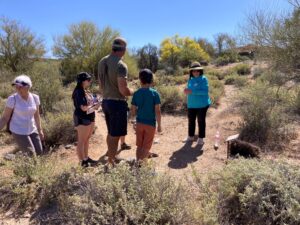Writer Joseph J. Airdo // Photography Courtesy of the Desert Awareness Committee



When Brenda Olive moved from Indiana to Arizona four decades ago, she was immediately thrilled by the prospect of not having grass to grow, bushes to trim and leaves to rake.
“[Arizona’s] bushes are slow growers with small leaves as an adaptation to only 8-12 inches of rain annually in the desert,” Olive says. “We know that the bigger the leaves, the more water a plant needs. You will see photos of lush creosote, jojoba and chuparosa bushes that require no watering or trimming — ever! Bushes such as the jojoba and wolfberry flower in the spring and their fruits follow a few months later.”
Falling in love with our miraculously easy-growing plant life, Olive became a member of the Desert Awareness Committee, a nonprofit organization that has been a community resource advocate for the Sonoran Desert since 1974. Its mission is to educate residents and visitors so that they may have the knowledge and skills on how to conserve and preserve our diverse and fragile desert — its plants, animals, water and wildlife.
“Our desert is not just cacti,” Olive explains. “It has full lush bushes that add color and sustainability to our desert. They provide erosion control and keep the ground underneath them moist and cool for its survival as well as a place for birds and animals to take cover. Birds and insects benefit from nectar in the blossoms, and the animals — yes, even humans — enjoy the fruits and seeds.”
In other words, Arizona’s ecosystem is both a precious luxury and a valuable necessity — and one that, believe it or not, knows how to take care of itself. In fact, human intervention can be quite detrimental.
“Here come the landscapers with their electric clippers to shape our beautiful bushes into balls or teacups, robbing them of their new flower buds and fresh green leaves,” Olive says. “These shapes are not attractive and do not reflect the integrity of the plant. Only a few years ago, we could admire the bushes in all their natural glory throughout the year. Now, there is a systemic issue with imprudent pruning of our native trees and bushes, which does more harm than good.
“When improper pruning is performed, such as shrub shaping, the plant uses its energy to replenish leaves where it was cut, altering the natural shape. Then this pruning takes place multiple times a year further exacerbating the problem with a dense woody plant on the inside that no longer has leaves. The inside doesn’t get sunlight, or the wind blowing through it to keep it cool. The plant’s shape is not only altered forever, but it is stressed and dies.”
Therefore, this spring, Olive and other committee members are stepping up efforts to educate the community about proper plant pruning — which should actually be done very sparingly.
“The real reasons for pruning are for safety and accessibility,” she explains, noting that one should only trim dead branches from the bottom of the bush with manual cutters, being careful to keep its original shape.
Olive encourages property owners to join the Desert Awareness Committee in advocating for the protection of our Sonoran Desert by stopping the devastation of its naturally beautiful foliage.
“If you have landscapers scheduled, be sure you meet them to walk your property and instruct them on which trees and/or bushes need trimming,” she adds. “Define what trimming means to you — and tell them to leave the electric trimmers in their truck.”







Comments by Admin